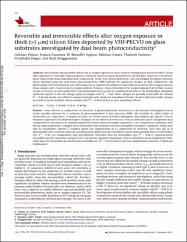Reversible and irreversible effects after oxygen exposure in thick (> 1 mu m) silicon films deposited by VHF-PECVD on glass substrates investigated by dual beam photoconductivity

Göster/
Tarih
2014Yazar
Yılmaz, GökhanCansever, Hamza
Sagban, H. Muzaffer
Güneş, Mehmet
Smirnov, Vladimir
Finger, Friedhelm
Brueggemann, Rudi
Üst veri
Tüm öğe kaydını gösterÖzet
Metastability and instability effects due to oxygen exposure in thick intrinsic hydrogenated microcrystalline silicon films deposited by very high frequency plasma enhanced chemical vapour deposition on smooth glass substrates were investigated using temperature-dependent dark conductivity, steady state photoconductivity, and sub-bandgap absorption measurements obtained using the dual beam photoconductivity (DBP) method. No significant changes in dark conductivity and photoconductivity were detected even after long-term air exposure of samples in room ambient as well as after oxygen exposure when samples were characterized in oxygen ambient. However, characterization of the oxygen-exposed state in high vacuum caused an increase in dark conductivity and photoconductivity as well as a significant decrease in the sub-bandgap absorption coefficient spectra in the low energy region in samples with I-C(RS) > 0.40. These changes are partially irreversible for samples I-C(RS) > 0.80 and mostly reversible for compact materials with significant amorphous fraction. No detectable metastable changes occurred in microcrystalline silicon samples with I-C(RS) < 0.40 as well as in pure amorphous silicon.

















